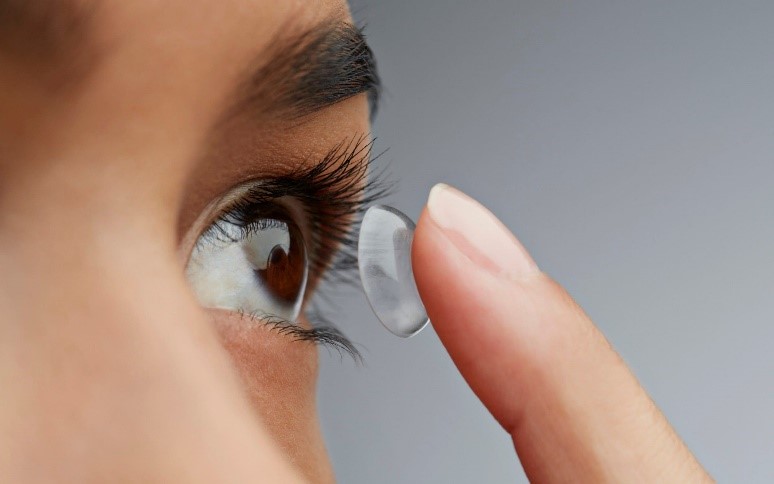Contact lenses are an excellent choice for nearly anyone who needs vision correction and doesn’t want to wear eyeglasses full time or who can’t undergo LASIK Surgery / SMILE procedure for any reason.
Contact Lenses
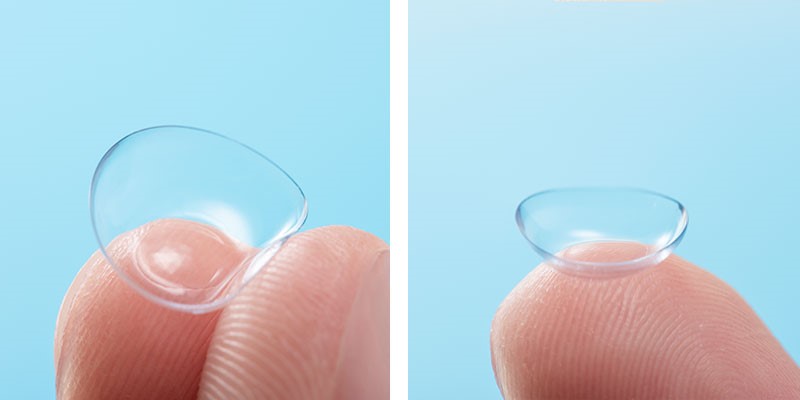
- Soft lenses are made from gel-like, water-containing plastics called hydrogels. These lenses are very thin and pliable and conform to the front surface of the eye.
- Silicone hydrogel lenses are made of an advanced type of soft contact lens material that allows more oxygen to pass through the lens and reach the front surface of the eye. Silicone hydrogel contact lenses are now the most popular type of contact lenses.
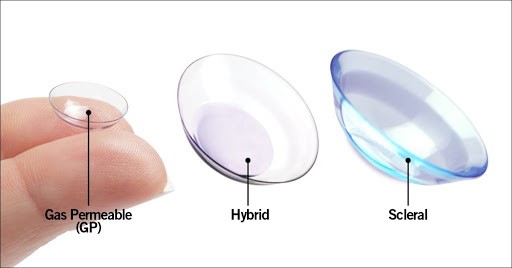
- Gas permeable lenses also called GP or RGP lenses, these are rigid contact lenses that maintain their shape on the eye, enabling them to correct astigmatism and other refractive errors. Gas permeable contact lenses typically are smaller in diameter than soft lenses and are made of highly oxygen-permeable materials. It usually takes some time for your eyes to adjust to GP lenses when you first start wearing them; but after this initial adaptation period, most people find GP lenses are as comfortable as soft lenses.GP lenses can be used for the treatment of Keratoconus as well.
- Scleral lenses Large-diameter gas permeable lenses called scleral contacts are specially designed to treat keratoconus and other corneal irregularities. Scleral lenses are used for the treatment of Keratoconus as well. In cases where the cornea has irregular astigmatism and cannot be treated with laser vision correction or cannot accept a new cornea (transplant) or in corneal transplants with bad vision due to high irregular astigmatism, scleral lenses properly fitted can dramatically improve vision.
- Hybrid contact lenses have a rigid gas permeable central zone, surrounded by a “skirt” of hydrogel or silicone hydrogel material. They are designed to provide wearing comfort that rivals soft or silicone hydrogel lenses, combined with the crystal-clear optics of GP lenses.
- Specialized Contact Lenses.
Orthokeratology, or Ortho-K, is a lens fitting procedure that uses specially designed rigid gas permeable (RGP) contact lenses to change the curvature of the cornea to temporarily improve the eye’s ability to focus on objects.
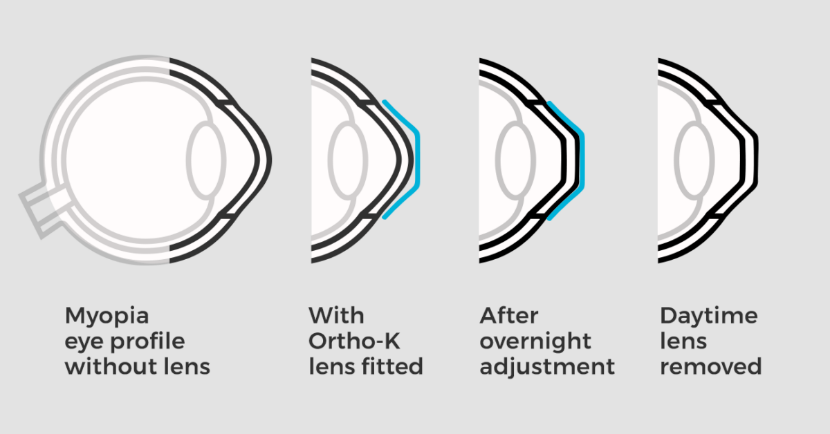
Overnight Ortho-K lenses are the most common type of Ortho-K. There are some Ortho-K lenses that are prescribed only for daytime wear. Overnight Ortho-K lenses are commonly prescribed to be worn while sleeping for at least eight hours each night. They are removed upon awakening and not worn during the day. Some people can go all day without their glasses or contact lenses. Others will find that their vision correction will wear off during the day.
The vision correction effect is temporary. If Ortho-K is discontinued, the corneas will return to their original curvature and the eye to its original amount of nearsightedness. Ortho-K lenses must continue to be worn every night or on some other prescribed maintenance schedule in order to maintain the treatment effect.
Ortho K lenses can have side effects like corneal ulcers.
Heralded as “a quantum leap forward in the evolution of lens design for the condition” of keratoconus the ROSE K lens has become the world’s most frequently prescribed gas permeable contact lens for keratoconus.
Unlike traditional contact lenses, the complex geometry built into every ROSE K contact lens closely mimics the cone-like shape of the cornea for every stage of the condition.
The result is a more comfortable fitting lens for patients and better sight (visual acuity).
Dr. Paul Rose further refined the ROSE K lens to take into account the unusual corneal shapes of keratoconus patients, which require abnormal curves on the back of the lens to fit the cornea optimally. This new lens is known as the ROSE K2 lens.
ROSE K Post Graft Lens is for patients who have undergone penetrating keratoplasty. This lens is designed for postoperative recovery and improvement in vision.
A bandage contact lens is designed to protect an injured or diseased cornea from the mechanical rubbing of the blinking eyelids, therefore allowing it to heal. The Bandage lens often makes the eye feel more comfortable. It is usually a soft lens, but not always. The lens has no focusing power. It is not intended to improve your vision.
Most commonly we apply bandage contact lenses for
1. Post LASIK or TransPRK or C3R to let the epithelium heal under it.
2. Corneal abrasions.
3. Recurrent corneal abrasions.
4. With tissue glue to seal a break in the cornea to temporarily save the eye before a transplant is made available.
There are two categories of contact lenses based on the recommended wearing time:
- Daily wear contact lenses — These must be removed nightly before sleep.
- Extended wear contact lenses — These can be worn overnight (for a limited number of days).
“Continuous wear” is a term that’s sometimes used to describe extended wear lenses that are worn 24 hours per day for up to 30 consecutive days.
Even with proper care, contact lenses (especially soft contacts) should be replaced frequently to prevent the build-up of lens deposits and contamination that increase the risk of eye infections.
Soft lenses have these general classifications, based on how frequently they should be discarded:
- Daily disposable lenses — Discard after a single day of wear.
- Monthly Disposable lenses — Discard every three weeks, or sooner.
- Frequent replacement lenses — Discard monthly or quarterly.
- Traditional (conventional) lenses — Discard every six months or a year.
Gas permeable contact lenses are more resistant to lens deposits and don’t need to be discarded as frequently as soft lenses. Often, GP lenses can last a year or longer before they need to be replaced.
Soft contact lenses (both hydrogel and silicone hydrogel lenses) are available in a variety of designs, depending on their intended purpose:
- Spherical contact lenses have the same lens power throughout the entire optical part of the lens to correct myopia (nearsightedness) or hyperopia (farsightedness).
- Toric soft contact lenses have different powers in different meridians of the lens to correct astigmatism (cylinder)as well as nearsightedness or farsightedness.
- Multifocal contact lenses (including bifocal contacts) contain different power zones for near and far vision to correct presbyopia as well as nearsightedness or farsightedness. Some multifocal lenses also can correct astigmatism.
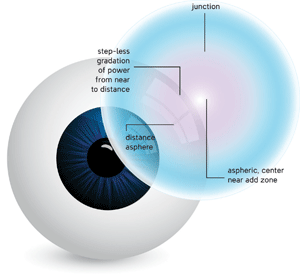
Bifocal contacts for astigmatism: These are advanced soft contacts that correct both presbyopia and astigmatism, so you can remain glasses-free after age 40 even if you have astigmatism.

Colored lenses: Specially developed lenses that allow the wearer to change their eye color – this could be for everyday wear or for special occasions.
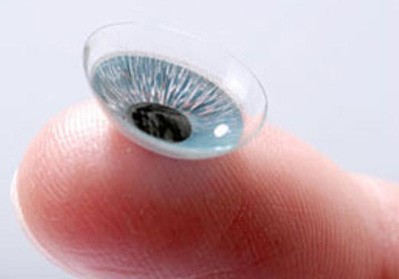
Prosthetic lenses: Colored contact lenses also can be used for more medically oriented purposes. Opaque soft lenses called prosthetic contacts can be custom-designed for an eye that has been disfigured by injury or disease to mask the disfigurement and match the appearance of the other, unaffected eye.
You only have one pair of eyes, so take care of them! Healthy Habits = Healthy Eyes. Taking proper care of your contact lenses can help you see better and keep your eyes healthy.
Contact Lens Health Starts with You – Your habits, supplies, and eye care provider are all essential to keeping your eyes healthy. Both contact lens wearers and eye care providers play an important role in proper eye care. By following your eye care provider’s instructions on how to properly wear, clean, and store your lenses, you can enjoy the comfort and benefits of contact lenses while lowering your chances of an eye infection.

 Don’t Sleep in Your Contact Lenses
Don’t Sleep in Your Contact Lenses
- Don’t sleep in your contact lenses unless prescribed by your eye care provider. Sleeping while wearing contact lenses has been shown to increase the chance of an eye infection by 6 to 8 times.
- Replace your contact lenses as often as recommended by your eye care provider.

Wash Your Hands
- Always wash your hands with soap and water before handling your lenses.
- Dry your hands well with a clean cloth before touching your contact lenses every time.

Keep contact lenses away from all water
- Water can introduce germs to the eyes through contact lenses. Remove contact lenses before swimming and avoid showering in them.

Properly Clean Your Lenses
- Rub and rinse your contact lenses with contact lens disinfecting solution—never water or saliva—to clean them each time you remove them.
- Don’t “top off” solution. Use only fresh contact lens disinfecting solution in your case—never mix fresh solution with an old or used solution.
- Use only the contact lens solution recommended by your eye care provider.
 Take Care of Your Contact Lens Case
Take Care of Your Contact Lens Case
- Clean your contact lens case by rubbing and rinsing it with contact lens solution—never water—and then empty and dry with a clean tissue. Store upside down with the caps off after each use.
- Replace your contact lens case at least once every three months.
 Talk with Your Eye Care Provider
Talk with Your Eye Care Provider
- Have a conversation with your eye care provider during your next appointment to discuss your contact lens wear and care habits and to help prevent eye infections.
- Visit your eye care provider yearly or as often as he or she recommends.
- Remove your contact lenses immediately and call your eye care provider if you have eye pain, discomfort, redness, or blurred vision.
 Be Prepared
Be Prepared
- Carry a backup pair of glasses with a current prescription—just in case you have to take out your contact lenses.

